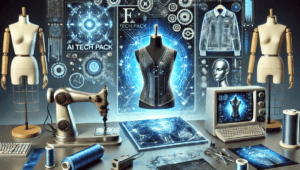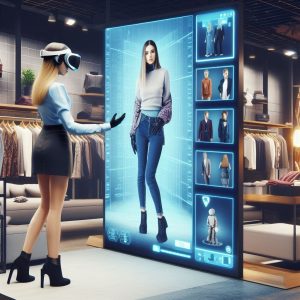Revolutionizing Fashion Design with AI Pattern Making
At the forefront of this revolution is AI pattern making, a cutting-edge technology that automates and optimizes fashion pattern design. Traditionally, creating garment patterns was a labor-intensive process requiring manual drafting and adjustments. Today, AI systems can make patterns in AI environments with unmatched precision and speed.
Tools like CLO 3D and Browzwear use AI algorithms to simulate garment construction, allowing designers to visualize how fabrics drape and move on virtual models. This eliminates the need for physical samples, significantly reducing development time and material waste. AI-generated patterns can be adjusted in real-time, enabling designers to experiment with styles, cuts, and materials more efficiently.
Automated Fashion Design Tools: Bridging Creativity and Technology
The fusion of creativity and technology is best exemplified by automated fashion design tools. These tools assist designers in creating unique patterns, enhancing the design process with data-driven insights and automation. By integrating AI garment design features, designers can experiment with complex structures, intricate patterns, and innovative textiles that were once challenging to conceptualize.
Brands like Tommy Hilfiger and Levi’s are incorporating AI into their design studios to streamline pattern creation and garment production. AI pattern making not only reduces human error but also allows for limitless customization, enabling brands to cater to diverse markets and individual preferences.
An exciting innovation is the ability to make patterns in AI using natural language prompts. Designers can input simple commands, and AI tools generate complex patterns that align with the specified criteria. This democratization of design empowers emerging designers and independent creators to produce high-quality collections without requiring extensive technical expertise.
AI in Garment Construction: Precision and Efficiency
AI in garment construction is revolutionizing how fashion brands manufacture clothing. AI-driven machines automate fabric cutting, stitching, and assembly, ensuring precision and consistency. Companies like Lectra and Gerber Technology have developed AI-powered fabric cutters that optimize material usage, reducing waste and operational costs.
By integrating AI-generated patterns with automated manufacturing systems, brands can seamlessly transition from design to production. This synergy reduces lead times and enables quicker market entry. AI garment design tools also allow brands to experiment with sustainable fabrics and alternative materials, meeting the growing demand for eco-friendly products.
Moreover, AI systems analyze garment construction data to identify potential flaws and suggest improvements. This proactive quality control reduces returns and enhances product durability, fostering a more sustainable fashion ecosystem.
Trend Forecasting with AI-Generated Patterns
Staying ahead of fashion trends is critical for brand success. AI excels in trend forecasting by analyzing vast datasets from social media, fashion shows, and shopping behaviors. This analysis helps brands predict which styles, colors, and AI-generated patterns will resonate with consumers.
Startups like Heuritech specialize in AI-powered trend forecasting, helping brands anticipate market shifts and align collections accordingly. By understanding emerging trends, brands can use AI pattern making tools to design garments that are both fashionable and commercially viable.
AI also identifies niche markets and micro-trends, enabling brands to create limited-edition collections tailored to specific customer segments, enhancing brand relevance and customer loyalty.
Customization and Personalization Through AI Garment Design
Modern consumers seek personalized fashion experiences, and AI garment design tools make this possible. AI analyzes consumer data to deliver customized clothing recommendations and enables brands to offer made-to-order garments based on individual preferences.
AI pattern making allows designers to adjust sizes, fits, and styles on demand, catering to diverse body types and personal tastes. Previously exclusive to luxury fashion, this customization is now accessible to mainstream markets through AI.
Brands like Nike and Adidas use AI to offer customizable shoes and apparel, allowing customers to choose colors, materials, and even personalized graphics. This on-demand production model satisfies consumer desires while reducing overproduction and inventory costs.
Sustainable Fashion Powered by AI
Sustainability is a growing priority in the fashion industry, and AI offers effective solutions to mitigate environmental impacts. AI pattern making optimizes fabric use, reducing material waste. AI-generated patterns eliminate the need for multiple physical prototypes, significantly lowering resource consumption.
Brands like Stella McCartney utilize AI to assess supply chain sustainability, ensuring ethical sourcing and production. AI-driven production systems also minimize energy use and reduce carbon footprints.
Additionally, automated fashion design tools support circular fashion by facilitating garment recycling and upcycling. AI identifies reusable materials and suggests design modifications to extend product lifecycles, contributing to a more sustainable industry.
Enhancing Quality Control with AI
Quality control is vital in fashion manufacturing, and AI strengthens this process with real-time monitoring and defect detection. Computer vision systems inspect garments for flaws, ensuring only premium products reach consumers.
AI also combats counterfeit goods, a major concern for luxury brands. Technologies like Entropy use AI to authenticate products, protecting brands and preserving product integrity. Integrating AI in garment construction guarantees strict quality standards, enhancing brand reputation and customer trust.
The Future of Fashion with AI
The future of fashion is intertwined with AI advancements. From AI pattern making to AI garment design, these technologies are transforming how brands innovate, produce, and market their collections. As AI continues to evolve, it will bridge the gap between artistic vision and technical execution, empowering designers to push creative limits while meeting market demands.
Emerging trends in AI-generated patterns, sustainable manufacturing, and personalized fashion are setting new industry standards. Brands adopting these innovations will achieve operational excellence and build stronger consumer relationships.
AI is no longer a tool—it is a strategic advantage enabling fashion brands to innovate, adapt, and thrive in a dynamic marketplace.




